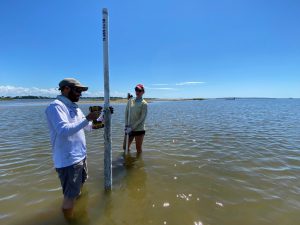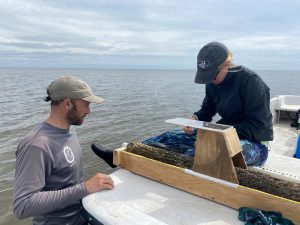Written by M. Clark, J. Marchionno, E. Wellman

Background
Spanning eight counties and largely free of development, Florida’s Nature Coast is one of the Gulf of Mexico’s untouched treasures. The region provides critical habitat to many species of fish, birds, invertebrates, and plants, some of which are threatened or endangered. Several small communities are dispersed along the Nature Coast’s shoreline and depend on its diverse ecosystem to support fishing, aquaculture, and ecotourism economies. However, research is increasingly showing that many of the natural resources critical to these communities are in decline. One of the most important species underpinning the Nature Coast’s ecosystem and the economy is the Eastern Oyster Crassostrea virginica. These shellfish are not only delicious, but also form subtidal and intertidal reefs which provide a myriad of ecosystem services including improved water quality, bird and fish habitat, and shoreline stabilization. The number and area of healthy oyster reefs throughout Florida is limited and their preservation and restoration will be critical to mitigating future effects from climate change and human actions.
Who are we?

The current condition of oyster reefs along the Nature Coast is poor and the challenge in revitalizing them is great. However, support from local communities like Cedar Key can help reduce these losses and pave a path towards recovery. In fact, several oyster reef and shoreline restoration projects in the area have gained broad support. Some notable projects include the Lone Cabbage Reef, Joe Rains Beach Living Shoreline, Airport Road Living Shoreline, and Atsena Otie Reef pilot, among others. Shoreline and oyster restoration projects primarily aim to mitigate coastal problems like erosion; however, each project is also an opportunity to conduct research that can improve restoration techniques more broadly and uncover the drivers which sustain – or impede – ecological function.
Enter Operation Spatfall (OS)! The brainchild of UF graduate students Emory Wellman (SFFGS), Joe Marchionno (ESSIE), and FL Sea Grant affiliate Dr. Mark Clark (SWS), OS is a multi-year research initiative focused on understanding the ecology of Cedar Key’s oysters, identifying drivers of decline on certain reefs, and evaluating methods that might lead to a successful restoration. Inspired by others’ previous efforts and expertise in the region, the OS team came together in September 2021, realizing we had a shared love of the region, its oysters, and research projects that improve our understanding of oyster ecology and restoration.
Each OS team member brings different skills and research interests to the project, but all with the ultimate goal of better understanding local oyster ecology and applying this knowledge to the benefit of the Nature Coast and beyond. We are excited to partner in our investigation with NCBS and the Cedar Key community and hope you will come along with us as we perform experiments and collect data, reporting back in this newsletter as our work develops.

JR-CSA experiments
The OS team is collaborating with FWC-FWRI and USFWS LSNWR to test the ability of a novel oyster reef substrate to recruit oysters and establish reefs in areas where the bivalves are in decline. Although oyster reef persistence may be suffering due to overharvesting, changing salinity regimes, and predation, the quality, and stability of substrate for oyster recruitment also appears to be a critical weakness. Oyster larvae are often abundant in these areas, but recruitment and survival are limited. To investigate substrate stability as a limiting factor of oyster establishment, a new material called jute-reinforced calcium sulfoaluminate (JR-CSA) is being investigated. Developed by Drs. Clark and Savanna Barry (NCBS, FL Sea Grant) originally as a component for living shorelines, this material has several distinct advantages as a reef restoration substrate: it is made of inexpensive, store-bought materials, the production process is simple and easily taught to volunteers and other stakeholders, and it can be formed in a variety of shapes, allowing it to be tailored to a given shoreline or restoration site. Two of the most common shapes presently used are panels and prisms, which are anchored to the substrate to recruit oysters, stabilize the site, and catalyze the reef-building process.
Although JR-CSA had been deployed previously in nearshore areas with great success, verifying the suitability of this material and determining critical elevations for deployment is necessary before any large-scale restoration can occur. As an initial test, the OS team deployed an array of JR-CSA substrates referred to as RODs (relative oyster datums). These RODs are made of 10′ long PVC poles, the lower half of which is wrapped in JR-CSA. RODs are then slipped over a metal fence post anchored to the sediment within the intertidal zone. The team installed 18 RODs at six sites north and east of Cedar Key. RODs will act as sentinels for settling larval oysters and help the team better understand a) if there is spatial and temporal variability in oyster settlement patterns, 2) where the optimal recruitment zone lies within the tidal profile, 3) how well oyster larvae attach and survive on the JR-CSA material, and 4) if there is any directional settling preference relative to the sun and wave energy exposure. Deployment locations were chosen along a wave energy gradient and in areas where JR-CSA material would likely be deployed in the future.

Monitoring of oyster spat recruitment on RODs is conducted by photographing the four cardinal facing directions of the ROD at 30cm elevation increments. Images are then visually inspected for any oyster spat recruits. After photographs are collected, the ROD is replaced and left to continue recruiting. The first sampling in November 2021 turned up mostly barnacles – another sessile invertebrate that loves to settle on hard materials. The dominance of barnacles vs. oysters is likely due to the RODs being deployed too late in the fall when oyster spawning and larval recruitment had ended for the year.
What’s next?
The OS team will be checking the RODs again in April and will deploy a new set to assess the 2022 spat recruitment cycle. Meanwhile, we are planning a larger scale pilot project at Corrigan Reef led by Marchionno to evaluate the layout of JR-CSA reef panels to investigate tradeoffs between the number of panels used, wave attenuation, and oyster recruitment, and determine if there are any preferences for foraging and roosting birds. Check back for an update as site scouting and material deployment get underway!
 1
1
